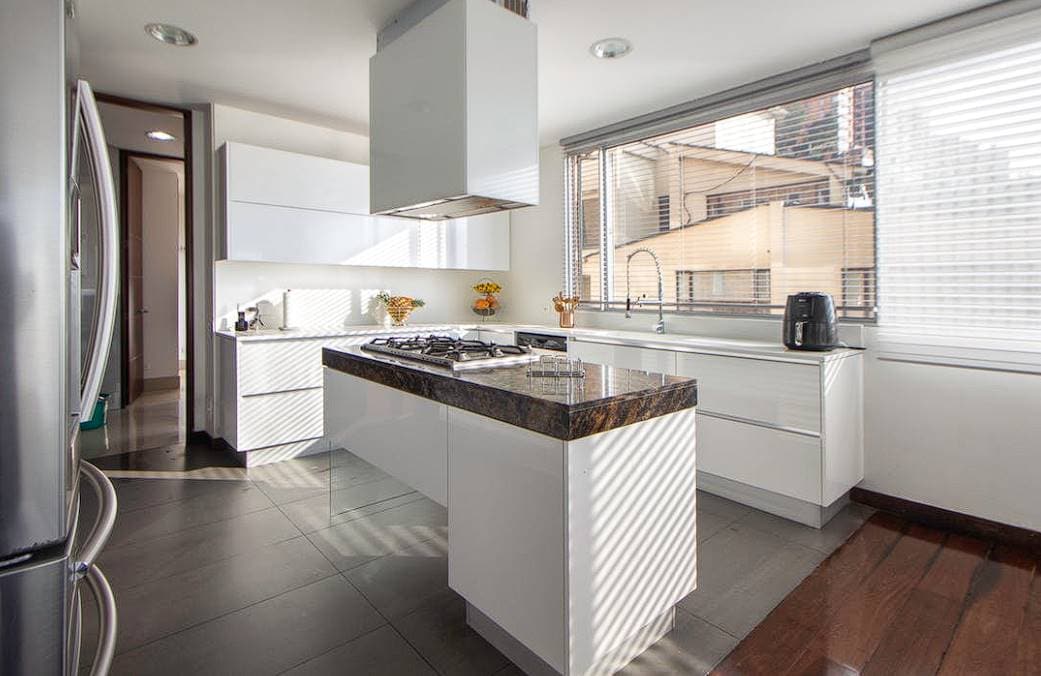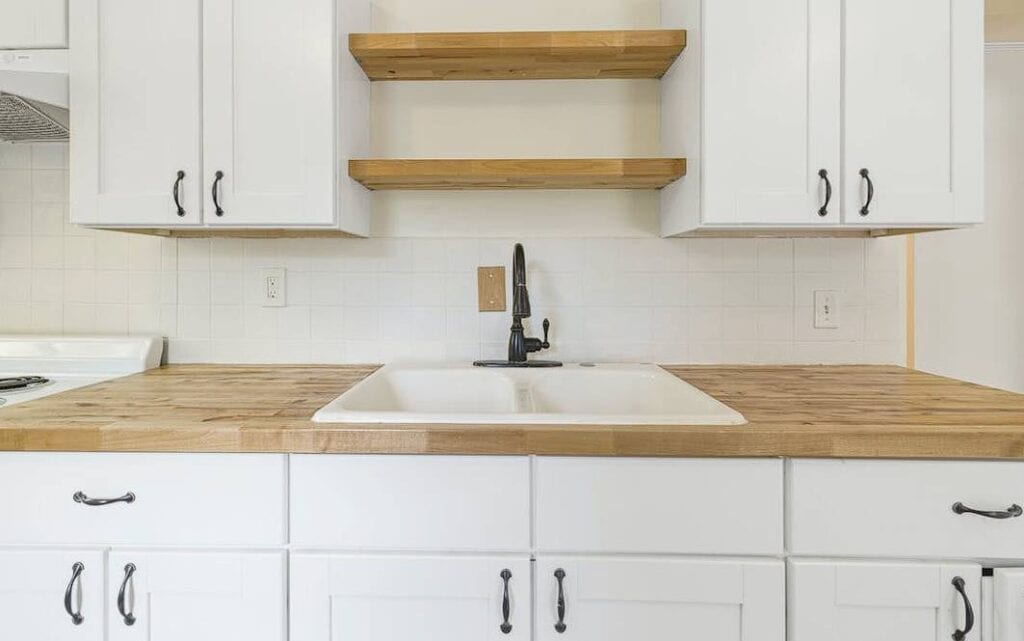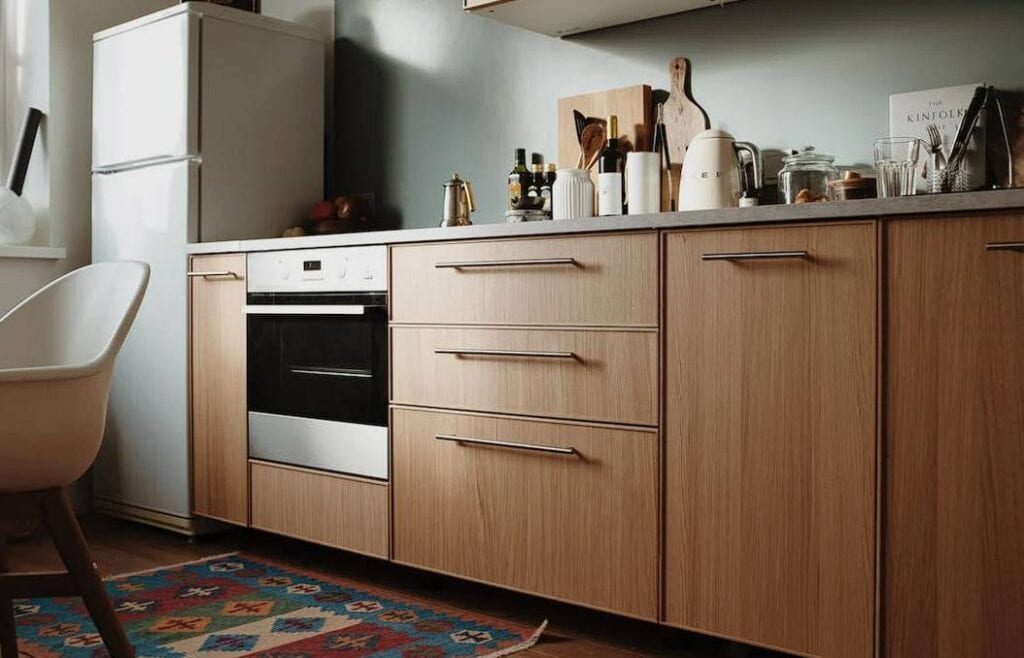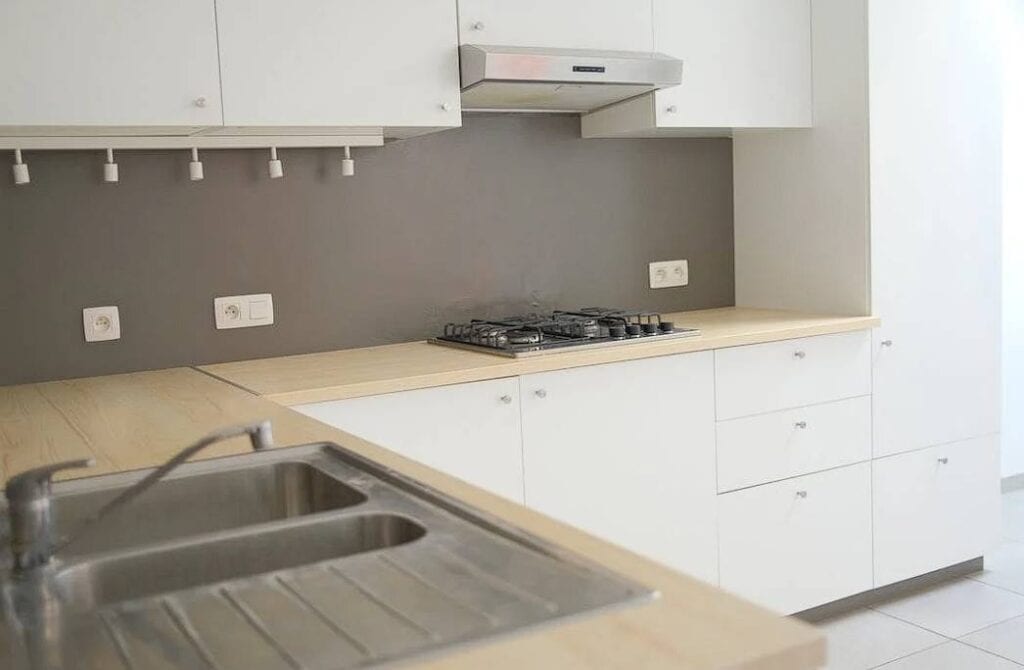Your kitchen cabinets are constantly chipped away by water, dust, grease, food particles, and even air exposure. That's why it's important to keep your kitchen cabinets clean on a regular basis; doing so will keep harmful bacteria from growing inside. In addition, a clean cabinet, especially made of wood, functions well and looks nice.
When should you clean your kitchen cabinets, though, exactly? Cleaning and maintaining your kitchen cabinets should be done every three to five months, though you should remove food smudges, cooking residues, and other stains from the surface or faces of the cabinets once a week. If you clean your kitchen cabinet once a week, you'll be helping to maintain a clean kitchen and a healthy environment at home.
Why Should Kitchen Cabinets Be Cleaned?
Cabinets in the kitchen get a lot of use and abuse. The constant opening and closing of cabinets can cause a thick layer of dust to accumulate on their surfaces, and the heat and moisture from the stove and sink can warp the veneer of the cabinets. So cabinet hardware (knobs, handles, hinges, and the like), even though the components you're using are sturdy, is something to keep in mind.
Cleaning your cabinets is a simple task in and of itself, but rather a problem of maintaining a consistent routine. While the occasional quick wipe is fine, more extensive measures may be required to remove stubborn stains. However, keeping your cabinets clean and germ-free for the long haul is as simple as following some basic maintenance guidelines.
If you want to avoid paying for professional cabinet cleaning services, you'll have to clean your cabinets yourself. You only need to remember the frequency, as there are numerous helpful guides on maintaining a clean cabinet.

The Perfect Kitchen Cabinet Cleaning Routine
First, when considering how often to clean your cabinet, keep in mind that different areas of the cabinet are subjected to different amounts of dirt and wear. You should clean your cabinet more thoroughly on the outside, where it is more exposed to the air than on the inside, where you have more leeway.
However, this also depends on your kitchen cabinet's contents and the frequency with which your kitchen is used. As a general rule, the more you use your kitchen, the more often you should expect to clean it.
Every Three To Five Months, Clean The Inside Of Your Cabinet.
You might not think much about cleaning the interior of your kitchen cabinets, but every time you open and close them, dust and other debris can get trapped inside. The presence of dust mites is particularly problematic for the safety of the food stored in dirty kitchen cabinets.
When cleaning the inside of your kitchen cabinets, it's important to remember the following:
- To prevent mould growth, interiors should be kept dry at all times.
- If you want to clean the inside of your cabinets, you'll need to empty them first.
- The growth of bacteria can be prevented by ensuring that nothing you plan to store again has passed its expiration date.
- To make future cleaning more manageable, use towels or other cloth covers to collect settling dust.
- After cleaning them, your cabinets need at least an hour or two to "breathe" or air out.
- It's important to remember to unwrap food completely.
- Inspect the inside of the cabinets for traces of mould or insect nests.
- A microfiber cloth is ideal for wiping down the interior because it can trap as much dust and dirt as possible without scratching the surfaces.
The interior of your kitchen cabinets may be cleaned infrequently, but they should be cleaned thoroughly once a year to guarantee the safety and cleanliness of your food supply. Even after washing, bacteria and grime can cling to the surfaces of dishes and other kitchen utensils, so it's best to avoid storing them inside.
Every Two Weeks, You Should Clean The Outside Of Your Cabinet.
In the case of a wall-mounted cabinet, the door, frame, and underbody are all external components of your kitchen cabinet. Therefore, these are the most exposed parts of your vehicle and need to be cleaned every two weeks.
When cleaning the exterior of your cabinet, keep the following in mind:
- Applying an antibacterial spray to a surface helps prevent the growth of bacteria and other microorganisms, some of which can be transmitted from raw food.
- If you want to protect your cabinet finish, don't use harsh chemicals or cleaners.
- You should also clean the knobs and handles on cabinets, as you will frequently touch them.
- Be sure to remove any built-up dust before wiping it away.
- After thoroughly cleaning the surface, a polishing cloth can bring out its shine.
- All-purpose cleaners are effective at removing tough stains like water or vinegar, but they can also damage the exterior of the cabinet if used improperly.
Cabinets made of metal or glass can withstand strong chemicals when used sparingly, but wooden cabinets require special care to prevent deterioration and necessitate milder cleaners. If you need help cleaning something, a damp cloth with a little dish soap should do the trick.
Factors To Consider For Cleaning Frequency
There are several factors to consider when deciding how often you should clean your kitchen cabinets. You can tailor your cleaning routine to your needs by considering these factors. Let's delve deeper into each of these:
Traffic And Usage
The amount of activity and foot traffic in your kitchen will significantly impact how often your cabinetry needs to be cleaned. For example, you may need to clean your cabinets more frequently if you have a busy household in which the kitchen is used all the time. This will allow you to keep up with the accumulation of grime, grease, and spills.
Cooking Habits
How often you should clean your kitchen cabinets is a major factor in determining how often you cook. More frequent cleaning of the cabinets will be required if frying or cooking at high heat is a regular part of your routine. However, if you rarely use oil or grease in your cooking, you may only need to clean your cabinets sometimes.
Stains And Dirt That Are Visible
When it comes to determining whether or not your cabinets need to be cleaned, a good indicator is to keep an eye on the dirt and stains that are visible on them. If you discover an accumulation of grease, dirt, or stains hurting your cabinets' aesthetic, it is a clear sign that they need to be cleaned. Clean your cabinets as soon as you notice the buildup.
Material Of Cabinets
In addition, the frequency of cleaning is affected by the material that your kitchen cabinets are made of. The care and maintenance that are required for various materials vary. For instance, cabinets made of laminate or metal are easier to clean and maintain, whereas wooden cabinets need to be cleaned more frequently to prevent moisture damage.
Environmental Factors
How quickly your kitchen cabinets get dirty also depends on the environment in which your kitchen is located. Dust and debris, for example, are more likely to make their way into your kitchen if it is near a busy road or construction site. If this is the case, you may need to clean your cabinets more frequently.
Step-By-Step Guide To Cleaning Kitchen Cabinets
It's easier than you might think to clean your kitchen cabinets. However, cleaning and maintaining spotless cabinetry requires a systematic strategy and the appropriate equipment. To guarantee a complete and effective cleaning, follow these steps:
Gather Supplies
Make sure you have everything you need before you get started. For example, you may need a brush attachment for your vacuum cleaner, microfiber cloths, a bucket, a mild cleaner appropriate for your cabinet material, hot water, a soft-bristled brush or toothbrush, and wood polish or conditioner.
Declutter And Remove Items
Get started by emptying your cupboards. This facilitates easy access to all areas, allowing for comprehensive cleaning. Then, do some cleaning and sorting while you're at it. Get rid of stale goods, donate unused items, and organise the rest.
Vacuuming And Dusting
Clean the inside and outside of the cabinets using a microfiber cloth or a vacuum cleaner with a brush attachment to remove dirt and debris. Dust tends to gather in nooks and crannies, so give that extra attention. Take care not to scratch easily damaged surfaces.
Wiping Surfaces
Mix a mild cleaner that is safe for the material of your cabinets with warm water. Use a clean microfiber cloth dipped in the solution and thoroughly wrung out to wipe down the inside and outside of the cabinets. Working from the top down, make sure you get everything. Use a toothbrush or soft-bristled brush to scrub areas with stubborn stains or grease buildup gently.
Keeping Hardware Clean
You should also wipe down your cabinets' knobs, handles, and hinges. Take them off and wash them in soapy warm water for a few minutes if you can. Remove any grime and dirt with a cleaning cloth or brush. Make sure they are completely dry before reattaching.
Conditioning And Polishing
Wood polishes and conditioners can be used on wooden cabinetry to restore its sheen and shield it from the elements. Apply the product with a clean cloth as directed by the manufacturer. The cabinets will look much nicer once you buff out the rough spots and make them shiny.
Allow Time For Drying
After cleaning your cabinets, give them enough time to air dry completely before replacing their contents. This helps prevent damage caused by moisture and ensures that the environment is kept clean and fresh.

Common Mistakes To Avoid
It's important to avoid damaging the surfaces or compromising the cleanliness of your kitchen cabinets by avoiding these common mistakes. You can keep your cabinets in good condition by avoiding these common blunders.
Let's talk about some of the most typical mistakes people make:
Making Use Of Abrasive Materials
Don't use anything abrasive When cleaning your cabinetry, like rough sponges or scrub brushes. If your cabinets are made of wood, these may damage the finish. Choose gentle cleaning tools made just for cabinets, like microfiber cloths, instead.
Failure To Properly Dry
It's important to dry your cabinets well once you've cleaned them. Wood and other materials are susceptible to damage from or the growth of mould and mildew when exposed to high levels of moisture. So after cleaning your cabinets, dry them thoroughly with a dry cloth or towel.
Neglecting Routine Maintenance
Kitchen cabinets need regular upkeep to last a long time and look great. Don't let dirt and stains accumulate to the point where they're noticeable before cleaning. Dusting, wiping down surfaces, and inspecting for wear and damage should all be part of your regular maintenance schedule.
Neglecting Hardware
The buttons and levers found on your drawers and cabinets and any other hardware should also be cleaned. Over time, fingerprints, grease, and dirt can accumulate here. Use a gentle cleaner regularly to preserve their appearance and usefulness.
Using Harsh Cleaning Products
Cabinets can be easily damaged by using too abrasive or harsh cleaners. Instead, choose gentle cleaners that won't scratch your cabinets' surface. Before using any cleaning product, read and follow the directions provided by the manufacturer.
Conclusion
Kitchen cabinets are constantly chipped away by water, dust, grease, food particles, and air exposure. Regular cleaning and maintenance are essential to prevent harmful bacteria from growing inside and maintain a healthy home environment. It is recommended to clean cabinets every three to five months, with food smudges and stains removed once a week. Cabinet hardware, such as knobs, handles, and hinges, should be kept in mind. Maintaining a consistent routine is crucial for long-term cleanliness and germ-freeness.
To avoid paying for professional services, it is recommended to clean cabinets yourself. The perfect kitchen cabinet cleaning routine involves cleaning the outside, where it is more exposed to the air, more thoroughly than the inside, where there is more leeway. The frequency of cleaning your kitchen cabinets depends on the frequency of use and the contents of your kitchen. The interior of your cabinets should be cleaned every three to five months to prevent mould growth and ensure food safety. To clean the interior, keep them dry and empty them before cleaning.
To prevent bacteria growth, use towels or cloth covers to collect settling dust. After cleaning, allow the cabinets to "breathe" or air out. Unwrap food completely and inspect the inside for traces of mould or insect nests.
The exterior of your cabinets should be cleaned every two weeks, especially for wall-mounted cabinets. Apply an antibacterial spray to prevent the growth of bacteria and other microorganisms, and avoid harsh chemicals or cleaners. Clean knobs and handles frequently and remove built-up dust before wiping it away. Polish the surface with a polishing cloth after thorough cleaning.
Factors to consider for cleaning frequency include traffic and usage, cooking habits, visible stains and dirt, material of cabinets, and environmental factors. Traffic and usage can impact the frequency of cleaning, while cooking habits can determine the frequency of cleaning. Visible stains and dirt indicate the need for cleaning.
To avoid common mistakes, it is essential to avoid damaging surfaces or compromising the cleanliness of your kitchen cabinets. By following these steps, you can maintain your kitchen cabinets in good condition and prevent potential issues.
Content Summary:
- Your kitchen cabinets are constantly chipped away by water, dust, grease, food particles, and even air exposure.
- That's why it's important to keep your kitchen cabinets clean on a regular basis; doing so will keep harmful bacteria from growing inside.
- When should you clean your kitchen cabinets, though, exactly?
- Cleaning and maintaining your kitchen cabinets should be done every three to five months, though you should remove food smudges, cooking residues, and other stains from the surface or faces of the cabinets once a week.
- If you clean your kitchen cabinet once a week, you'll be helping to maintain a clean kitchen and a healthy environment at home.
- Cabinets in the kitchen get a lot of use and abuse.
- Cleaning your cabinets is a simple task in and of itself, but rather a problem of maintaining a consistent routine.
- However, keeping your cabinets clean and germ-free for the long haul is as simple as following some basic maintenance guidelines.
- If you want to avoid paying for professional cabinet cleaning services, you'll have to clean your cabinets yourself.
- You only need to remember the frequency, as there are numerous helpful guides on maintaining a clean cabinet.
- First, when considering how often to clean your cabinet, keep in mind that different areas of the cabinet are subjected to different amounts of dirt and wear.
- You should clean your cabinet more thoroughly on the outside, where it is more exposed to the air than on the inside, where you have more leeway.
- However, this also depends on your kitchen cabinet's contents and the frequency with which your kitchen is used.
- As a general rule, the more you use your kitchen, the more often you should expect to clean it.
- You might not think much about cleaning the interior of your kitchen cabinets, but every time you open and close them, dust and other debris can get trapped inside.
- The presence of dust mites is particularly problematic for the safety of the food stored in dirty kitchen cabinets.
- To prevent mould growth, interiors should be kept dry at all times.
- If you want to clean the inside of your cabinets, you'll need to empty them first.
- To make future cleaning more manageable, use towels or other cloth covers to collect settling dust.
- After cleaning them, your cabinets need at least an hour or two to "breathe" or air out.
- It's important to remember to unwrap food completely.
- Inspect the inside of the cabinets for traces of mould or insect nests.
- A microfiber cloth is ideal for wiping down the interior because it can trap as much dust and dirt as possible without scratching the surfaces.
- The interior of your kitchen cabinets may be cleaned infrequently, but they should be cleaned thoroughly once a year to guarantee the safety and cleanliness of your food supply.
- Even after washing, bacteria and grime can cling to the surfaces of dishes and other kitchen utensils, so it's best to avoid storing them inside.
- In the case of a wall-mounted cabinet, the door, frame, and underbody are all external components of your kitchen cabinet.
- Therefore, these are the most exposed parts of your vehicle and need to be cleaned every two weeks.
- When cleaning the exterior of your cabinet, keep the following in mind: Applying an antibacterial spray to a surface helps prevent the growth of bacteria and other microorganisms, some of which can be transmitted from raw food.
Frequently Asked Questions
To remove sticky residue from kitchen cabinets, you can follow these simple steps:
- Start by creating a mixture of warm water and mild dish soap.
- Dip a clean cloth or sponge into the soapy water solution.
- Gently scrub the sticky residue using a damp cloth or sponge.
- If the residue is stubborn, use a non-abrasive cleaner or a mixture of equal vinegar and water.
- Apply the cleaner to the residue and let it sit for a few minutes to loosen the stickiness.
- Use a soft cloth or sponge to scrub the area again, focusing on the sticky residue.
- Rinse the cabinet surface with clean water to remove any cleaner or soap residue.
- Dry the cabinets thoroughly with a clean cloth.
Yes, you can use vinegar to clean wooden cabinets. Vinegar is a natural and effective cleaner that can help remove dirt, grime, and grease from wooden surfaces. However, diluting the vinegar before using it on your cabinets is important to avoid any potential damage.
It's best to avoid using oil-based cleaners on kitchen cabinets, especially if they have a lacquer or painted finish. Oil-based cleaners can leave behind a greasy residue and may damage the surface of the cabinets. Instead, stick to mild, non-abrasive cleaners suitable for your cabinet material.
To maintain the shine of wooden cabinets, regularly dust them and wipe them down with a soft cloth. Avoid using abrasive cleaners that can dull the finish. Applying a wood polish or conditioner once every few months can also help enhance the lustre and protect the wood.
Yes, there are natural alternatives you can use to clean kitchen cabinets. Vinegar diluted with water is a popular natural cleaner that removes dirt and grime effectively. Baking soda mixed with water or lemon juice can also be a gentle abrasive cleaner. Always test these solutions on a small, inconspicuous area first.


